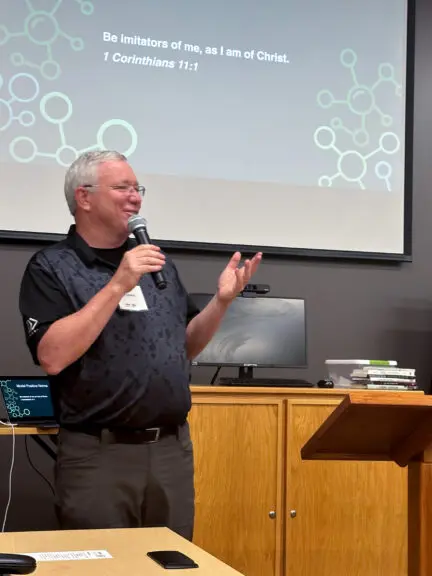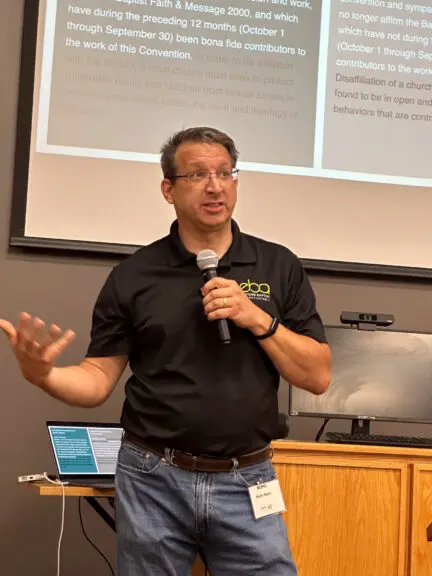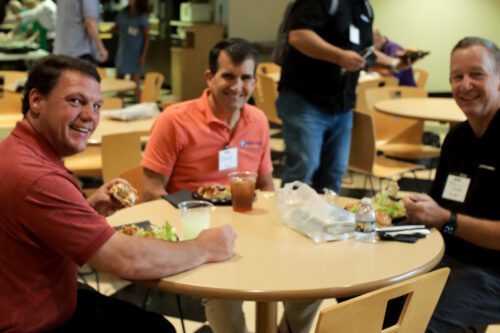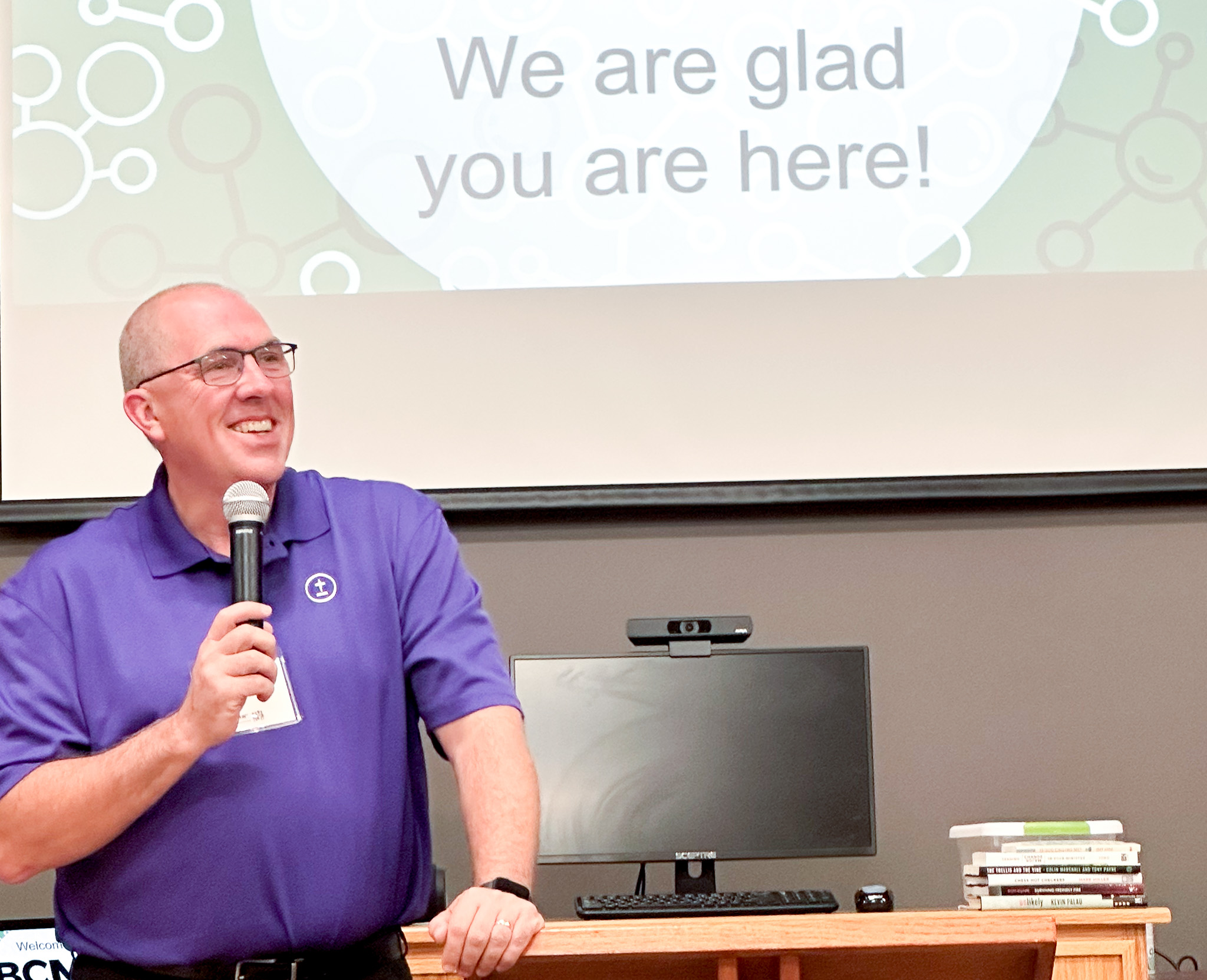One hundred individuals representing 75 churches registered for last week’s BCM/D Roundtables featuring Southern Baptist Convention (SBC) President Bart Barber.
BCM/D partnered with The Matthew 5:9 Fellowship to offer the events at several locations throughout Maryland/Delaware, including LifeHouse MOT in Townsend, Delaware, and three Maryland churches — Riva Trace Baptist Church, Davidsonville; Mountain City Church, Frostburg; and Westminster Baptist Church. Each session also included an update from the BCM/D Sexual Abuse Task Force.

Associate Executive Director Mark Dooley welcomed guests to the BCM/D Roundtable. (Photo by Sharon Mager)
Introducing the theme of reducing toxic polarization and seeking peace, Matthew 5:9 Fellowship Program Director Brandon Cleaver shared, encouraging churches to be peacemakers in a polarized society. Cleaver said sometimes Christians in churches can be on opposite ends of the spectrum on certain issues. The problems are when we begin to have negative attitudes towards one another — not just not regarding the issue, but having an “I don’t like you” attitude.
Cleaver emphasized sharing and affirming identities and values and modeling positive norms.
Drawing Circles
Discussing unity issues in churches, and the convention, Dr. Barber, a history scholar, shared about times throughout the decades when Baptists disagreed and either fractured or learned to work together. He referred to Pennepack Church in Philadelphia. In the 1700’s members disagreed over the ordinance of laying on of hands. A group left and formed Welsh Tract Baptist Church in Delaware. Church leaders from both churches, however, later met together, talked, and decided that though they could not be at fellowship at the Lord’s Table with each other because of the difference in belief, they agreed that either church could commune with one another, visit and worship. Those who wanted to participate in the laying on of hands had the liberty without offense, and they had the right to preach or debate with all freedom consistent with charity and brotherly love.
Barber explained, “What they’ve done here is that they had deeply held differences over a doctrinal question and wondered does this put us beyond the boundaries of  being compatible or not? They talked to each other and worked out an understanding where they said, it doesn’t. We can be compatible churches with one another based on the things we believe in common in spite of the things we have differences in belief about. They worked out a solution where they said we’re going to show respect over differences about doctrinal matters that are not so significant to form a separation.”
being compatible or not? They talked to each other and worked out an understanding where they said, it doesn’t. We can be compatible churches with one another based on the things we believe in common in spite of the things we have differences in belief about. They worked out a solution where they said we’re going to show respect over differences about doctrinal matters that are not so significant to form a separation.”
Reflecting on that history and current events, Barber said, “Cooperation survives from partnering churches satisfying themselves that the forces that bring them together, that make them compatible, are stronger than the things that pull them apart in terms of diversity and difference and disagreement.
“When churches can’t do that, when they can’t respect difference — when they think it does damage compatibility, they split and form something else, and you end up with more than one group.
“Eventually,” he said, “every group of autonomous churches faces both of these forces. It’s a part of this whole attempt for us to cooperate with one another. I think we ought to respect the reality of this when we talk to one another about differences in belief.”

Keith Myer, the chair of the BCM/D Sexual Abuse Task Force shared about Caring Well Sunday on Sept. 24. (Photo by Sharon Mager)
Barber used the illustration of drawing circles either very tightly and small or very large.
“The fact of the matter is that all of us have doctrinal lines we draw that set the boundaries of cooperation, defining what’s compatible…it’s just a different place we’re drawing a line.”
Barber said the issues do tend to be self-correcting over time. Is there a risk that these autonomous churches will be so strict that eventually, 40,000 churches in one convention turn into 40,000 conventions where we draw the line tighter and tighter until no one is in it but ourselves? “Is there a risk of that? Yes. But it has never happened in the history of Baptist church life. Why? Because as you draw circles tighter and tighter eventually, you get lonely. You first start drawing lines and you are excluding strangers then eventually grandchildren, a best friend from high school. Personal connections help us not to draw it in too tightly.”
“If you draw it too broadly it’s heresy, and it’so broad you don’t even know why you’re there.”
Though Barber fielded a variety of questions, he did emphasize that regarding SBC decisions,“It’s ultimately the messengers who make decisions, and I’m there to protect their rights to make those decisions.”

Pastors enjoy fellowship following a Roundtable event at Riva Trace Baptist Church. (Photo by Sharon Mager)
Question topics included women in ministry, fairness in representation, compatibility, the North American Mission Board, The Great Commission Resurgence, and the SBC Abuse Reform Task Force.
BCM/D Task Force Update
Keith Myer, the chair of the BCM/D Task Force, with Kris Buckman, shared updates about the BCM/D Sexual Abuse Task Force. They highlighted the upcoming September 24 Caring Well Sunday. Barber shared that more clarity is needed on several issues, and he emphasized compatibility versus autonomy.
There was a time of fellowship over a meal following each event.

